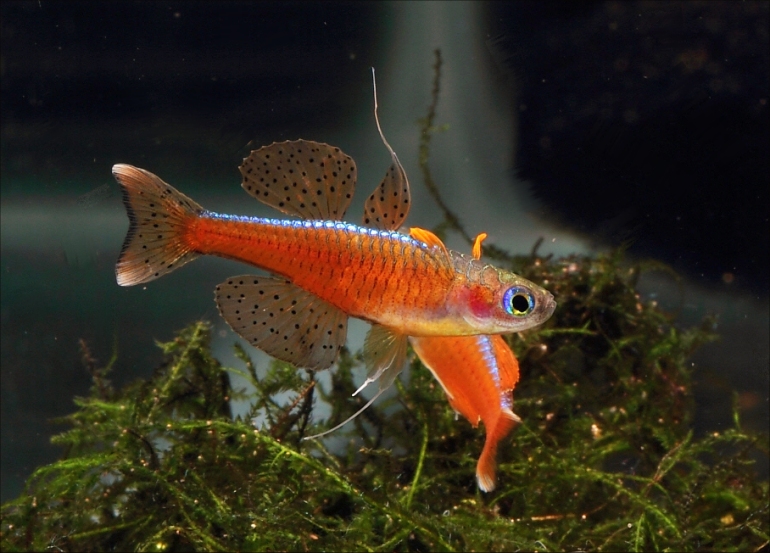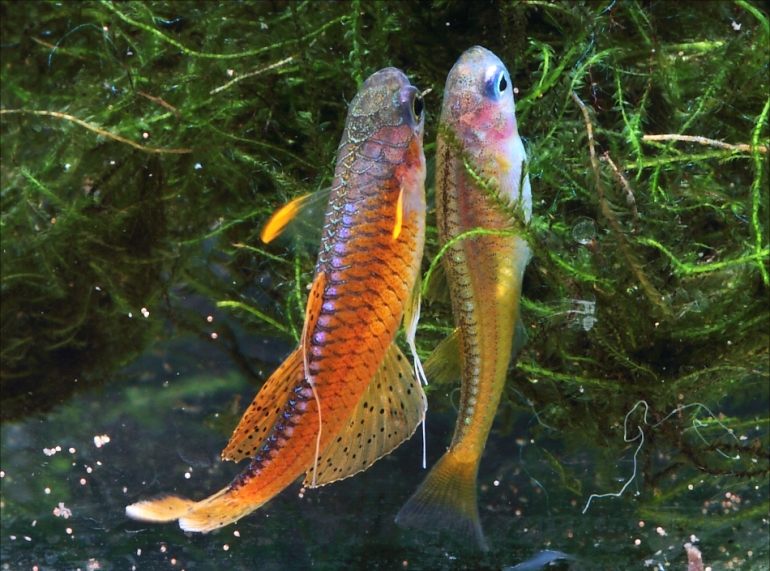|
 |
Pseudomugil luminatus - photo© Taoyeah Deng |
Allen, Unmack and Hadiaty, 2016
Red Neon Blue Eye
Species Summary
Pseudomugil luminatus males have a body colour that is generally yellowish tan, yellow orange, or reddish with scales thinly outlined with brown, sometimes silvery white on belly and breast. They have a neon-blue stripe on the uppermost part of the body extending from the rear part of the head to the base of the uppermost caudal-fin rays. Median fins are generally yellowish-tan to pale-orange, variably marked with widely scattered small black spots; the anal and caudal fins generally have fewer spots, and those of the anal fin are mainly confined to the basal half or posteriormost section. The first dorsal fin has a narrow white anterior margin, white colour extending onto elongate fin filament. The caudal fin has prominent white tips on dorsal and ventral lobes; pelvic fins translucent yellowish with elongate orange filament anteriorly. The pectoral fins are mainly translucent with bright yellow or white mark along the upper edge of fin. The snout and upper part of the head is pale greyish to blue grey, usually with a red hue on the opercle due to the underlying red gill filaments and transparent nature of the thin outer covering of scales and bone. The eye pupil is black and iris bright blue. The females' body colour is generally similar to that of the male, although smaller individuals are more yellowish and semitransparent; fins mainly translucent to slightly yellowish, usually without spots.
Pseudomugil luminatus is most similar to Pseudomugil paskai from the upper Fly River system (Kiunga area) of Papua New Guinea, which lies approximately 530 km east of the known range of Pseudomugil luminatus. The two species exhibit a similar appearance and general morphology, especially the pattern of scattered black spots on the median fins, and elongate filaments on the first dorsal and pelvic fins of adult males. However, Pseudomugil luminatus differs from Pseudomugil paskai in usually having 10 rather than 11 anal-fin rays, 9 vs. 9-10 pectoral-fin rays, 25-26 vs. 27-28 lateral scales. Moreover, the body and fins of adult males of Pseudomugil paskai are considerably paler and lack the neon-blue stripe along the upper body that is characteristic of Pseudomugil luminatus. Additionally, genetic studies provide strong support for the separation of these species. The new species is named luminatus (Latin: light up) with reference to the bright colours exhibited by adult males.
 |
Pseudomugil luminatus spawning - photo© Taoyeah Deng |
Distribution & Habitat
Pseudomugil luminatus is currently known from south-central New Guinea in the vicinity of Timika, West Papua. Their habitat consists of swamps with clear (although darkly stained), slow-flowing water. The type locality, which lies about 20-25 km upstream of the Aikwa River estuary was severely altered by sediment tailings from the Freeport gold and copper mine in the late 1990s and this species and other swamp-associated fauna are presumed to be no longer present. Most of the paratypes were taken from two sites in the Iweka River system, approximately 31-36 km northwest of the type locality at elevations of 45-60 metres above sea level. Selected water quality values at the time of collection were as follows: temperature 26-28°C, pH 4.8-7.2 and conductivity 7-126 µS/cm.
Remarks
Museum specimens of Pseudomugil luminatus were originally collected in 1997 from a Sago swamp in the vicinity of Timika in West Papua (4° 40.669'S, 136° 57.046'E) by G. Allen, S. Renyaan and K. Hortle, but were formerly identified as Pseudomugil paskai.
In 2011, a new blue-eye became available in the aquarium trade and sold under a number of different names such as Pseudomugil sp. "Red Neon", the name which was used by exporters in Thailand and Indonesia, "Pseudomugil iriani" and Pseudomugil cf. paskai. Initially it was thought that they were just a different coloured form of Pseudomugil paskai that differed slightly in colouration and fin shape. Then in 2013, a second colour form was imported from Indonesia. These were very similar, but the base body colour was more yellowish. The males are easier to distinguish from the original variant by having deep orange-coloured tips to the caudal fin and almost transparent pectoral fins, again with orange tips. However, there is little doubt that both colour varieties belong to the same species, although the yellow form also differs somewhat from the red in body shape: the former is somewhat slimmer and has a more pointed head. But the neon-coloured dorsal band alone makes the species unmistakable. The females of the two variants look extremely similar.
Pseudomugil luminatus is a beautiful blue-eye and have become almost as popular as Melanotaenia praecox amongst hobbyists, even those that do not normally keep rainbowfishes.
Literature
Allen G.R., P.J. Unmack and R.K. Hadiaty (2016) Pseudomugil luminatus, A New Species of Blue-eye (Teleostei: Pseudomugilidae) From Southern New Guinea, With Notes on P. gertrudae. Fishes of Sahul 30(1): 950-961.
Evers H. (2012) Orangeblaue Blitze - ein neues Blauauge ist da! Amazonas 8 (4): 42-45.
Adrian R. Tappin
May, 2016



|
|

